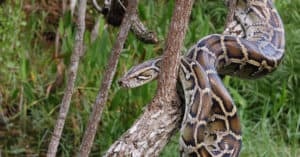Introduction
When it concerns the fascinating world of snakes, few types capture the creative imagination fairly like the child tiger snake. Understood for their unique coloration and powerful venom, these serpents are an integral component of Australia's distinct community. In this detailed post, we will certainly explore numerous aspects of baby tiger snakes, including their actions, habitat, and how to securely interact with them. Whether you're a wildlife enthusiast or just interested about these animals, comprehending infant tiger serpents can help cultivate a deeper gratitude for nature.
Baby Tiger Snakes: What You Required to Know About Their Actions and Habitat
What Are Infant Tiger Snakes?
Baby tiger snakes are juvenile forms of the highly venomous types known clinically as Notechis scutatus These snakes are mostly located in seaside areas of Australia, particularly Snakebite first aid in Tasmania and southern Victoria. As they expand, their pigmentation modifications from an extra low-key combination to the particular yellow and black bands that give them their name.

One notable aspect of child tiger snakes is their size; hatchlings usually gauge around 25-30 centimeters in length. Regardless of their tiny stature, they possess an unexpected amount of poison that can be harmful to human beings if bitten.
Physical Characteristics
Tiger serpents possess several key physical characteristics:
- Coloration: The unique banding pattern commonly becomes extra pronounced as they mature. Size: Adults can reach lengths of approximately 2 meters. Body Shape: They have a durable body that helps in swimming and earthbound movement.
Where Do Child Tiger Snakes Live? Comprehending Their Habitat
Understanding the environment choices of baby tiger snakes is important for both conservation efforts and public safety. These serpents prosper in numerous environments:
- Wetlands: Marshes and swamps offer sufficient hunting grounds. Coastal Regions: Typically located near coastlines where they can search for prey. Woodlands: Thick plants provides cover from predators.
Geographical Distribution
Tiger snakes are predominantly located yellow faced whip snake along Australia's southerly coast, consisting of:
- Tasmania: Home to one of one of the most well-known populations. Victoria: Especially in areas near water bodies.
Are Tiger Snakes Venomous? A Deep Study Their Venom
One usual concern develops when reviewing infant tiger snakes: "Are tiger snakes poisonous?" The answer is a definite yes!
Venom Composition
The poison of tiger snakes consists of neurotoxins that can create paralysis, coagulopathy (blood clot concerns), and potentially death if untreated. Here's what you require to know:
- Effects on Humans: A bite from a tiger snake can lead to signs like swelling, discomfort at the bite site, nausea or vomiting, and also breathing failure.
Comparison with Various other Venomous Snakes
In contrast to various other Australian serpents such as the eastern brownish snake or king brownish snake, tiger serpent venom is thought about among the most powerful. Nevertheless, casualties are rare due to enhanced medical therapies and access to antivenom.
Behavioral Patterns of Child Tiger Snakes
Understanding just how child tiger snakes act is important for those that stay in or check out locations where these reptiles are prevalent.
Nocturnal Habits
Most infant tiger serpents show nighttime behavior. They have a tendency to forage for food throughout types of dangerous snakes cooler night temperatures. This versatility assists them prevent predators while improving their hunting efficiency.
Hunting Techniques
Their searching strategies consist of:

- Ambush Predation: Waiting still until victim comes close. Active Foraging: Proactively relocating via plant life or along rivers in search of food.
First Aid for Snake Bites: What You Should Know
Despite being interesting creatures, experiences with baby tiger serpents can result in unsafe scenarios if bites take place. Knowing emergency treatment procedures can conserve lives.

Immediate Steps After a Bite
Remain calmness; panic boosts heart rate. Immobilize the affected arm or leg utilizing a splint or bandage. Seek prompt clinical interest-- antivenom may be necessary.Creating a Snake Bite First Aid Kit
A well-prepared emergency treatment kit should consist of:
|Product|Purpose|| ------------------------------|--------------------------------------|| Compression plaster|To paralyze the limb|| Splint|Supports damaged bones or joints|| Antihistamines|Reduces allergies|| Emergency situation contact numbers|Quick accessibility throughout emergency situations|
Common Myths Concerning Tiger Snakes Debunked
Many misconceptions border these fascinating reptiles; let's clear up some mistaken beliefs commonly held by people.
Myth # 1: All Tiger Snakes Are Aggressive
While some individuals might exhibit protective actions when intimidated, not all tiger snakes display screen aggression in the direction of humans unless provoked.
Myth # 2: Infant Tiger Snakes Are Less Harmful Than Adults
This misconception might not be further from the fact! Child tiger snakes contain nearly as much venom as grownups relative to their dimension; thus they position considerable threats if bitten.
FAQs Concerning Baby Tiger Snakes
What do baby tiger snakes eat?- They mostly consume tiny animals, birds, frogs, and fish.
- Look for slim bodies with faint banding patterns that end up being a lot more obvious as they mature.
- Yes! Birds of target and larger reptiles may target them.
- Typically every couple of weeks as they grow rapidly during their early life stages.
- While some individuals do keep them illegally without authorizations due to their dangerous nature; it's usually not recommended given their venomous status.
- With prompt medical treatment-- including antivenom-- the survival price is high!
Conclusion
In summary, comprehending baby tiger serpents-- what they eat, where they live, just how they act-- can furnish us with beneficial understanding regarding these impressive yet unsafe creatures. The value of education and learning bordering emergency treatment steps can not be overstated; recognizing how to react efficiently after a bite can conserve lives while cultivating respect for our crawling next-door neighbors within Australia's abundant biodiversity spectrum.
By valuing these serpents' duties within ecological communities-- and identifying prospective hazards-- we promote conjunction rather than fear-based reactions toward one another's existence in nature's grand tapestry! Whether you're a passionate hiker contemplating your next experience or just interested regarding neighborhood wild animals encounters near home-- this overview serves as your trusted referral point on the enigmatic world inhabited by our friends-- the magnificent baby tiger snake!